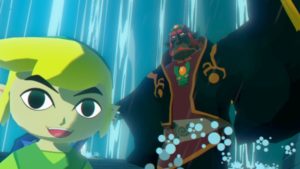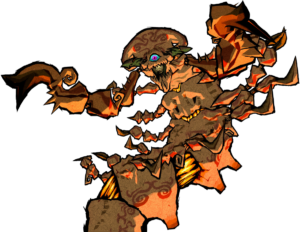The game I’m going to write about today is called The Legend of Zelda: Wind Waker. It’s designed for the Nintendo GameCube and was created in 2002.

Main menu of the game
The main character of the game is called Link, a young boy who appears to be sleeping in the beginning of the game (and quite evidently in most other Zelda games). The game itself consists of a main quest, which is to complete various dungeons through puzzle and problem solving in order and then defeat the main antagonist, Ganondorf (who has taken Link’s sister and has held her prisoner along with some other young girls, and it just so happens that Zelda, the female protagonist, is one of the prisoners and later on helps you defeat him), and some side quests and extras that can be completed at any point during the game, given that you have the relevant items (a single item is found in each dungeon, so you will be able to collect items as you complete the dungeons).

Obtaining items in the game
An important thing to mention would be the game controls. Link can roll on the ground (and also perform other actions when the time is right) by pressing “A”, swing his sword with “B”, map various items to “X”, “Y”, “Z”, change the camera angle with “L”, “R”and “C”. It is important to note here that Link isn’t given a button for jumping, and that he automatically jumps when approaching a ledge, which seems to be a recurring attribute in many 3D Zelda games. Perhaps this is to make the game itself slightly more challenging.The game was probably going for a “chibi”or “cute” general aesthetic, since all the characters seem to be relatively small, with large eyes, this generally appeals to a wide range of audiences, from children to adults and across genders. In terms of mechanics, the game is an open-world and free-roam type of game. That is, you are allowed to visit and move around the universe this game is set in, however, you will need to go through with the main quest before being allowed to play in certain locations in the universe (for example, you will only be able to play in head-stone island with the power bracelets. Without them, you would only be able to visit the island without playing in it). This was implemented to give the player a sense of freedom, but not too much freedom as the player still has some obligations in game, which is to finish the quests step-by-step. There are different types of enemies, such as keese (very annoying bats) and bosses that are quite region specific (Gohma, a large spider like boss which you battle in a volcanic cavern / Jalhalla, a collection of ghosts merged into one, battled in an abandoned or haunted temple). You are also not allowed to leave the universe, if you try to leave out of bounds, the King of Red Lions (your talking boat) will force you to turn around and sail in another direction.

“Chibi”or “cute” art style in the figure above

Gohma, shown in the figure above
The idea of free movement really brings a focus onto the player and the main character because the player is allowed to control link to go to wherever they please, given that the area is not out of bounds. Link is not completely bound by the rules of the game, but has to abide by some of the laws that have been implemented by the creator (e.g. no jumping by control, no traveling out of bounds, attack chickens in game at your own risk) which gives him human-like characteristics that we can relate to. In relation to this, the game is given a sense of meaning because the player has to complete several tasks before he gains the ability to continue with the game, which we can really see in our everyday lives (e.g. a child cannot learn how to run before walking), as well as the obvious sense of ethics and morality that the game preaches (the guy who brings darkness and injustices into the world is not exactly “good”, but the one who banishes the darkness is considered a hero). However, an important thing to note is that as you reach the end of the game, Ganondorf gives a little speech on his view of the world around him, and justifies why he did what he’s done, which again adds meaning to the game because more often than not, there are multiple sides of a single story, even though you end up defeating him anyway because it is played in the perspective of Link.

Ganon’s side of the story (part 1)

Ganon’s side of the story (part 2)